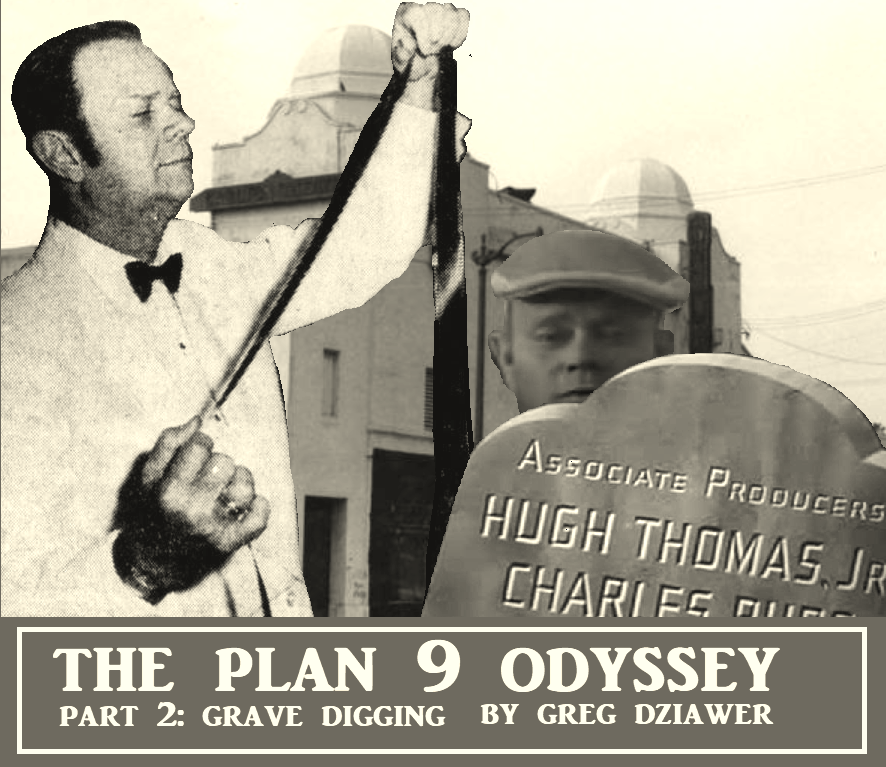 |
| Plan 9 producer/gravedigger Hugh Thomas; (background) the Carlton Theatre. |
It's time once again to delve into the hidden history of Edward D. Wood, Jr.'s most well-known film, the one that serves as the cornerstone of his cult stardom: the unique sci-fi/horror hodgepodge known as Plan 9 from Outer Space. Some might assume that everything worth saying about this patched-together 1957 film has already been said, especially since Plan 9 has inspired a documentary of its own (1992's Flying Saucers Over Hollywood) as well as countless articles and essays. The making of Plan 9 was also memorably dramatized in Tim Burton's fanciful biopic Ed Wood (1994). But even after all that, my research continues to turn up interesting little gems about this misunderstood classic.
In our first Plan 9 Odyssey, for instance, I shared a 1959 ad for the film that contained a statement from one of the film's associate producers, Hugh Thomas, Jr.
Well, it turns out that ad was for a showing at the Siesta Drive-In in Sarasota, Florida in 1959, and as this September 16, 1970 newspaper article indicates, Hugh Thomas himself had designed and fully engineered the Siesta years prior.
In addition to the background information about the Siesta, this article brings to light many startling things. To wit:
1. Although it's often presumed that Hugh Thomas was a member of the Southern Baptist Convention of Beverly Hills, he makes no mention of it here. That particular religious institution looms large in the Plan 9 myth, as all Wood fans know. Thomas is said to have been a member in the 1950s, along with his Plan 9 producer and costar J. Edward Reynolds, who passed in early 1959 and was thus robbed of the gratification of what the film would become. Plan 9 associate producer Charles Burg was also alleged to have been part of this congregation. Interestingly, in this article, Thomas firmly places himself in roles working in and around managing movie theaters for his entire career.
2. Given Thomas' pioneering and jubilant celebration of Plan 9 for its "bad" qualities in his statement in the ad in 1959, his estimation here over a decade later that the film was a "success" is either ballyhoo or bespeaks its financial ROI. The latter, never calculated to my knowledge, must be estimable, given the film's ubiquity in drive-ins and then TV syndication for more than two decades, only to rise again and remain so since as prototypical cult object. That said, it's apparent that Thomas was no more a financial benefactor of that "success" than Ed was.
3. The Peacemaker (1956) appears to have been the only film into which the Southern Baptist Convention successfully trojan-horsed its religious views. Although he is not credited, and the IMDb claims the crew to be complete, Thomas mentions himself as producer both here and in the 1959 ad. In this article, he says that he co- produced it with Hal R. Makelim, the credited producer. And here, he claims that Plan 9 was another co-production by the pair. I can find no evidence of Makelim ever being involved in Plan 9 from Outer Space.
4. Hal R. Makelim was, like Ed, another would-be entrepreneur trying to catch a big break in Hollywood. Beyond The Peacemaker, his scant credits include the forgotten programmer Man of Conflict from 1953—also his sole directorial credit—starring John Agar. Makelim served as Agar's manager at the time. Agar never appeared in a Wood film, though he likewise still gets his fair share of "worst actor" attributions owing to the bargain-basement run of schlock he indiscriminately appeared in throughout the '50s. By the early '70s, if not considerably earlier, Agar and Ed had become drinking buddies.
5. Agar and Thomas were, like Eddie the Marine, WWII vets, John in the Navy and Hugh in the Army. This correspondence demonstrates, in the proverbial bigger picture, just how commonly that conflict was a doubtless crucial part of the lives of so many people, remaining so today.
6. After his "failed" partnership with Makelim, Hugh Thomas bought the 1,200-seat Carlton Theatre in Los Angeles. If that name rings a bell, it was the venue for the world premiere of (then-titled) Grave Robbers from Outer Space, on Friday, March 15, 1957, then (per this article) under Thomas' ownership. A survey card from the premiere sold on Ebay for almost $1300 a little less than a year ago.
7. The Carlton occupied 5411 South Western in Los Angeles from the '20s through its closure in 1959. The building was demolished by the early '70s, making way for a McDonald's.
Besides serving as producers and financiers on Plan 9, Hugh Thomas and J. Edward Reynolds are best known and loved by Wood fans today for their memorable roles as the film's ill-fated gravediggers. These two bumblers die an offscreen death, dispatched violently by Vampira, but not before delivering this characteristically Woodian exchange:
Hugh (the tall and younger gentleman on the left): You hear anything?
J. Edward: Thought I did.
Hugh: Don't like hearing noises, especially when there ain't supposed to be any.
J. Edward: Yeah, kinda spooky-like.
Hugh: Maybe we're getting old.
J. Edward: Well, whatever it is, it's gone now.
Hugh: That's the best thing for us, too, gone.
J. Edward: Yeah, let's go.
Incidentally, as the historical record indicates, these guys are not the narrow-minded, uptight autocrats as depicted in Tim Burton's Ed Wood. They are clearly regular joes, magically appearing in a soon-to-be and unbeknownst-to-them exalted circumstance.


